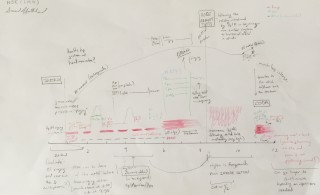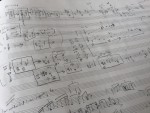Title

After I’ve found my tools for a piece, I sketch a color-coded timeline of events that I’d like to happen. I don’t necessarily stick to this sketch, but I do often refer to it and even rewrite it during the process of composing to see how my timeline is evolving. I think composition is a macro-based art form—in my experience, a listener generally grasps a holistic image of a new piece, rather than small moments or gestures, so I try to present my ideas to tailor that phenomenon.—Saad Haddad
The New Juilliard Ensemble, led by Joel Sachs, will present, among other works, pieces by Juilliard students Joshua Cerdenia and Saad Haddad.
Body
Joshua Cerdenia
 Rodgers and Hammerstein Scholarship, Irene Diamond Graduate Fellowship, Elliott Carter Memorial Scholarship in Composition
Rodgers and Hammerstein Scholarship, Irene Diamond Graduate Fellowship, Elliott Carter Memorial Scholarship in Composition
My piece Spoliarium was inspired by a massive 1884 painting by Filipino artist Juan Luna of lifeless gladiators being dragged into a dark chamber amid a riotous crowd of spectators. I originally intended a direct musical depiction, but as I worked, it became clear that the music wanted to go in directions I didn’t anticipate. Ultimately I came to my own abstraction of the Roman spoliarium, a subterranean chamber attached to an arena, where dead or dying gladiators were sent to be stripped of their armor and dispatched. I’ve made many references to other music, some subtle and some blatant. Like Luna’s gladiators were, I’ve dragged them into a chamber of my own invention to be looted of whatever I might find useful to my own purposes. (Photo by Wasin Prasertlap)
Saad Haddad
 The title of my N.J.E. work, Takht (“ensemble” in Arabic), describes a typical Middle Eastern musical group, and its instrumentation is the Western equivalent of that ensemble, employing one of each of the most commonly used instruments in the full symphony orchestra. Some of the instruments overlap between the groups; the ney is similar to the flute in construction, while the kamanjah sounds very much like the violin. An ongoing muse of mine is Umm Kulthum (1898–1975), arguably the most famous Egyptian singer ever. In this work, her voice is brought to life as the woodwinds, brass, and harp instrumentalists literally sing and play into their instruments, transforming the hall into an abstract depiction of her permeating presence in the lives of millions of people who continue to adore her today.
The title of my N.J.E. work, Takht (“ensemble” in Arabic), describes a typical Middle Eastern musical group, and its instrumentation is the Western equivalent of that ensemble, employing one of each of the most commonly used instruments in the full symphony orchestra. Some of the instruments overlap between the groups; the ney is similar to the flute in construction, while the kamanjah sounds very much like the violin. An ongoing muse of mine is Umm Kulthum (1898–1975), arguably the most famous Egyptian singer ever. In this work, her voice is brought to life as the woodwinds, brass, and harp instrumentalists literally sing and play into their instruments, transforming the hall into an abstract depiction of her permeating presence in the lives of millions of people who continue to adore her today.
I approach composition as an act of discovery, finding new ways to play Western instruments particularly influenced by Middle Eastern performance technique, timbre, melody, and rhythm. I often workshop my works with Juilliard’s fantastic performers and show them recordings of musicians from the Middle East and ask them how one might mimic the sounds on typical Western instruments and then notate those techniques. (Photo by Michael Lenahan)





